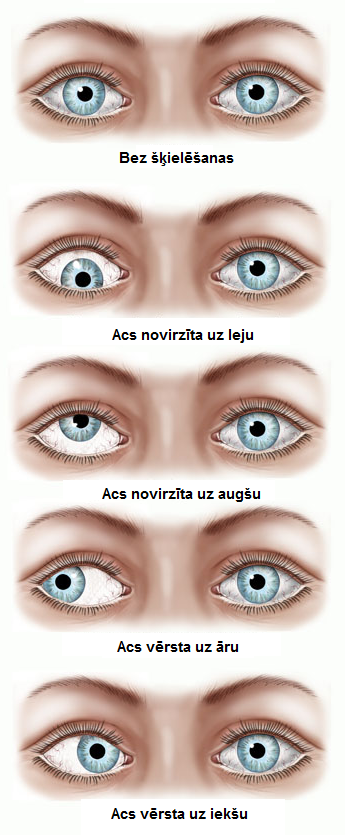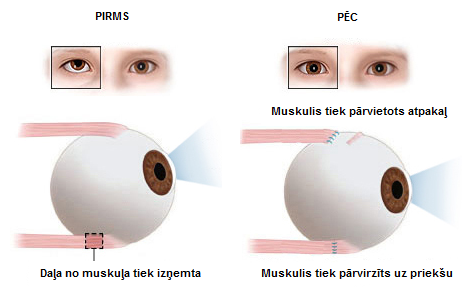To find out about the most suitable vision correction option, register for a visit, or find out other important information, leave your contacts, and we will contact you as soon as possible.
Strabismus correction
Strabismus is a visual pathology in which the eye muscles cause a periodic or permanent deviation of one or both eyes from the direction of total vision fixation, often resulting in a decrease in visual acuity.
- Strabismus can have both limited and unrestricted eye movements.
- The angle of strabismus can also be the same for both eyes. Still, it can vary from a few degrees that parents may not even notice, for example, to several degrees, which becomes a cosmetic and psychological problem for the patient and causes significant visual discomfort.
The vision of a healthy person is binocular - when the brain is connected to the image perceived by each eye in one common image, allowing us to see the world around us in three dimensions and accurately perceive the environment's spatiality.
In the case of strabismus, the images of both eyes do not merge into one, and the central nervous system learns to ignore the information sent by the strabismus eye to the centres of vision.
If strabismus occurs at an early age and only in one eye, vision problems may occur.
The baby does not "learn" to look with this strange eye, resulting from which amblyopia (lazy eye) develops over time - a functional, reversible deterioration of vision when one eye is less involved or does not participate at all.
If strabismus starts in an adult or child later in life, complaints of double vision usually occur.
Strabismus is not just a cosmetic problem.
Even in cases where the patient does not experience a decrease in visual acuity, stereoscopic vision is lost. Strabismus interferes with the spatial environment's perception, and the patient is unable to distinguish the size and volume of objects.
Depending on the direction of the eye
There are several types of strabismus. Horizontal, vertical or combined strabismus occurs:
- Horizontal strabismus:
- convergent strabismus - the eye moves inwards,
- divergent strabismus - the eye turns outwards.
- Vertical strabismus:
- the eye moves upwards,
- the eye shifts down.
- Combined strabismus:
- a combination of horizontal and vertical strapping, such as when one eye moves upwards and the other outwards,
- cyclotropia, or circular strabismus, in which one eye deviates from the other in a clockwise or counterclockwise direction,
- heterophoria or hidden strabismus. There may be compensated occult strabismus diagnosed by a doctor through special tests, partially compensated occult strabismus that occurs periodically, such as in stressful situations, extreme fatigue, and decompensated occult strabismus that occurs for no reason and usually manifests itself in increased visual fatigue, visual fogging, doubling.
A distinction is also made between congenital strabismus diagnosed in infants under six months of age and acquired strabismus in children later in life and adulthood.

Types of strabismus are different, because their causes are different.
The most common causes of strabismus are:
- genetic inheritance, congenital syndromes (e.g. Down syndrome),
- idiopathy (unknown cause),
- refractive errors (moderate to a high degree of hypermetropia or farsightedness, myopia or astigmatism),
- amblyopia or lazy eye,
- damage to the nerves that are innervating the muscles of the eye movement in the brain (paresis),
- anatomical features of eye movement muscles, orbits,
- eye diseases - cataracts, glaucoma, retinal diseases, etc.
- general conditions of the body (e.g. autoimmune diseases - myasthenia gravis, Graves' disease),
- various types of injuries, such as head injuries, childbirth injuries, psychological injuries (such as strong fear), etc.
- pathologies affecting the brain, such as tumours, stroke, cerebral palsy, etc.
Strabismus can cause both visual and general health problems.
If strabismus has started in adulthood, the patient may experience symptoms such as:
- rapid eye strain,
- image duplication (diplopia),
- the blur of image outlines,
- the feeling of heaviness in the eyes,
- difficulty reading or doing other activities that strain your eyesight,
- loss of depth and volume perception.
To compensate for the visual problems caused by strabismus, many patients try to tilt their head in a position that relieves strabismus symptoms, often resulting in an abnormal curvature of the cervical vertebrae.
Also, in many cases, strabismus prevents patients from establishing regular visual contact with interlocutors, which can significantly affect mutual relations, create difficulties in socializing, interfere with getting a job, etc.
Strabismus correction
Options for correcting strabismus depend on the type of strabismus, the degree and cause of strabismus, as well as the visual acuity, the patient's age, and general health. Therefore, treatment can be:
- treatment of general illness;
- correction with glasses or contact lenses. As refractive errors - nearsightedness or farsightedness, can cause strabismus - in such cases, it can be prevented by prescribing appropriate glasses or contact lenses for the patient;
- ocular occlusion for the treatment of amblyopia. As mentioned above, strabismus can appear at an early age. If your child has only one eye, the doctor may prescribe an occlusion of the non-glare eye, or eye sealing or blurred vision in the whole eye with pupil-expanding drops to "train" the lazy eye and make it "watch".
- correction with prismatic spectacle lenses. In the case of a slight angle of strabismus, it is possible to correct vision with prisms - special spectacle lenses, which on the one hand are thicker. Prisms change the direction of light entering the eye and reduce eye rotation to view objects;
- orthopaedic treatment or eye muscle exercises can be used both as a particular treatment method. The patient can perform independently at home and in combination with other strabismus correction methods. Eye muscle exercises promote the accommodation of eye muscles or the ability to adapt to seeing objects at different distances and coordination between the eyes.
- surgical treatment - is performed for both adults and children, evaluating the necessity and usefulness of surgery to correct strabismus.

The patient needs to be aware that sometimes several surgeries are required to get the desired result.
Because the brain directs and controls eye movements through the brain's nerves, it must be understood that eye muscle surgery is not brain surgery, and surgical changes in muscle length and position do not change the signals transmitted by the brain to the eye muscles. Therefore, there is a possibility that strabismus may recur after the operation.
Remember! Each case of strabismus is individual!



